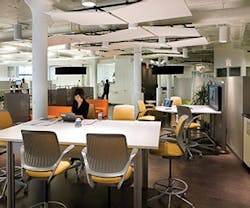Rows of cubicles can be as dull and rigid as a Rubik’s Cube, but collaborative spaces introduce more activity and flexibility into the workplace.
“As enclosed offices have phased out, the shift to open office plans has allowed more collaborative spaces to come in,” says Marc Margulies, principal at Margulies Perruzzi Architects (MPA), a firm that specializes in collaborative design. “People think they’re losing space, but if you introduce more huddle and gathering places, then you’re not really losing out.”
Regardless of your facility type, there are ways to reimagine and reconfigure your workplace to create a more engaged workforce.
“Start with a discussion of how you’re working now and how you’re going to work in the future,” Margulies suggests. “Focus on how to best utilize your real estate.”
Use Furniture that Fosters Engagement
There are two different metrics to consider with occupancy: square footage per occupant vs. per workstation. While cubicles are shrinking, collaborative spaces allow the space allotted per person to be maintained.
Consider how your space is employed now. Is the large conference room being used only a couple times per month? Is the café area used at all? Most of the time, only about 70% of workstations are actually occupied, Margulies estimates.
Meld traditional heads-down work with huddle spaces in the same environment, says Jonathan Webb, vice president of business markets for manufacturer KI. This can be provided with lounge furniture common in student centers.
“Companies want to attract and retain young talent. What better way to do that than to look at where your new employees just spent the last four to six years of their lives?” Webb says. “Lounge or bistro areas naturally foster community.”
These areas are ideally incorporated around the perimeter of the building where traffic passes, says Pedro Ayala, director of architecture and design strategies for manufacturer Kimball Office.PageBreak
“Those settings have social and collaborative benefits and accommodate small impromptu meetings,” he says.
Workers also expect more control over how and where they work, says Scott Sadler, product manager of integrated technologies at manufacturer Steelcase. “Provide them the ability to adjust tables, chairs, stools, and benches,” he says.
Sitting at a desk all day isn’t healthy or ideal, and certain offerings address that concern. “If you don’t have 8- by 10-foot spaces to move around horizontally anymore, allow employees to move vertically with sit-stand desks,” suggests Webb. “It keeps them engaged.”
Collaboration among employees also hinges on a space’s ability to be reconfigured. Movable walls and partitions are key.
“Furniture needs to take care of four or five different scenarios,” says Derek Schweikarth, industrial designer for manufacturer National Office Furniture. “You should be able to create workspaces that are conducive to mobility, reconfigurability, and functionality.”
Accommodate Different Work Styles
Collaborative spaces need connections so that the space is more than just a chat area. “Furniture must facilitate the work tools,” Schweikarth says.
Many offerings now incorporate some type of outlet or charging for mobile devices. Some even include screens.
“Whatever device you bring to a meeting, you should be able to share that information with the group,” says Sadler. “Collaboration should give everyone a voice and allow them to participate.”
Depending on what you want to accomplish, your options are endless. “Furniture used to be contained in silos,” Sheikarth says. “You had either office or education, but those lines are blurring.”
As those offerings have blended together, so have work styles.
“Collaboration takes on different forms. You have informative, which might be a leader-led presentation that takes place at a table,” says Sadler. “Evaluative is reflecting and could be a lounge setting to kick back with a coffee. Generative work might be a more active setting, with project teams at stool or standing height or moving throughout the space.”
Getting started on providing this atmosphere can be as simple as repurposing one small space with a couple new pieces.
“Take an a la carte approach,” says Webb. “You can take an old fashioned looking environment, swap out a few pieces, and simply create a more open, inviting area for engagement and collaboration.”
Chris Curtland [email protected] is assistant editor of BUILDINGS.
